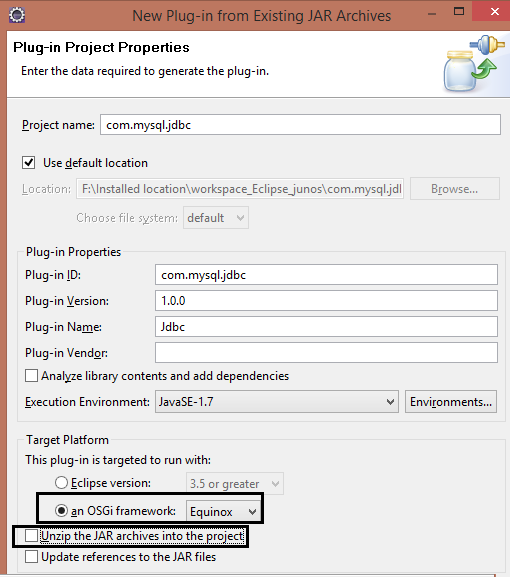
- SAP Community
- Products and Technology
- Technology
- Technology Blogs by SAP
- SMP 3.0 : Integration Gateway with MySQL Datasourc...
Technology Blogs by SAP
Learn how to extend and personalize SAP applications. Follow the SAP technology blog for insights into SAP BTP, ABAP, SAP Analytics Cloud, SAP HANA, and more.
Turn on suggestions
Auto-suggest helps you quickly narrow down your search results by suggesting possible matches as you type.
Showing results for
Product and Topic Expert
Options
- Subscribe to RSS Feed
- Mark as New
- Mark as Read
- Bookmark
- Subscribe
- Printer Friendly Page
- Report Inappropriate Content
07-05-2014
5:16 PM
| PART 1 | PART 2 | PART 3 | PART 4 |
|---|
Next step is to enable MySQL's JDBC driver for OSGi, then deploy it to SMP 3.0 server, create OData Modeling & deploy to SMP server.
Enabling MySQL's JDBC driver for OSGi
- Since MySQL JDBC driver is not archived as OSGi bundle, so it can not be read and understood by SMP3 (as SMP3 is based on OSGi), hence to make it work we need to create an OSGi enabled bundle which includes MySQL JDBC driver.
- Download MySQL's JDBC driver from here.
- Open Eclipse>New>Other>Plug-in Development>Plug-in from Existing JAR Archives
- Click on 'Add External' and browse to jar file

5. Provide some project name
- Make sure you select Target Platform as Equinox
- Uncheck unzip the JAR archives into the project

6. Once done, Right click project> Export>Plug-in Development>Deployable plug-ins and fragments
- Define some location to store OSGi enabled jar file
- Click on 'Finish'

Configure SMP 3.0 server for Integration Gateway JDBC connection
- As already mentioned above, SMP3 is based on OSGi so it is very much possible to deploy any JDBC driver as OSGi enabled jar package on SMP runtime.
7. Copy the OSGi enabled jar file (in my case, it is at Desktop), paste it into C:\SAP\MobilePlatform3\server\pickup
- To verify if jar file has been deployed successfully, open .state folder and see the 'OK' message

OData modeling
8. Make sure you have added GWPA plugin in the eclipse. For more information, check this document.
9. Create an OData project. File>New>Service Implementation Project
10. Check 'Create OData file manually' option

11. Create a model file. Right Click Model>New>Other>OData model
- Give some name for Model i.e. empModel
- Make sure you have selected 'Blank OData Model' from Initial Model content option
- Click on 'Finish'.

12. Create an Entity model same like your table structure in backend system.
- Make sure Entityset has the same name as Table name in database
- All properties should have same name and data type as per table in the database
- Change the EMPID data type to INT

13. Right click model>empModel.odata>Implement service
14. Right click empModel.odatasrv>Select Data source as JDBC

15. Right click project>Generate and Deploy Integration content
- You may prefer any other name for Service Namespace. By default it is 'sap'.

Make sure you get a success message.

Next Part 3
- SAP Managed Tags:
- OData,
- SAP Mobile Platform
You must be a registered user to add a comment. If you've already registered, sign in. Otherwise, register and sign in.
Labels in this area
-
ABAP CDS Views - CDC (Change Data Capture)
2 -
AI
1 -
Analyze Workload Data
1 -
BTP
1 -
Business and IT Integration
2 -
Business application stu
1 -
Business Technology Platform
1 -
Business Trends
1,661 -
Business Trends
88 -
CAP
1 -
cf
1 -
Cloud Foundry
1 -
Confluent
1 -
Customer COE Basics and Fundamentals
1 -
Customer COE Latest and Greatest
3 -
Customer Data Browser app
1 -
Data Analysis Tool
1 -
data migration
1 -
data transfer
1 -
Datasphere
2 -
Event Information
1,400 -
Event Information
65 -
Expert
1 -
Expert Insights
178 -
Expert Insights
280 -
General
1 -
Google cloud
1 -
Google Next'24
1 -
Kafka
1 -
Life at SAP
784 -
Life at SAP
11 -
Migrate your Data App
1 -
MTA
1 -
Network Performance Analysis
1 -
NodeJS
1 -
PDF
1 -
POC
1 -
Product Updates
4,577 -
Product Updates
330 -
Replication Flow
1 -
RisewithSAP
1 -
SAP BTP
1 -
SAP BTP Cloud Foundry
1 -
SAP Cloud ALM
1 -
SAP Cloud Application Programming Model
1 -
SAP Datasphere
2 -
SAP S4HANA Cloud
1 -
SAP S4HANA Migration Cockpit
1 -
Technology Updates
6,886 -
Technology Updates
408 -
Workload Fluctuations
1
Related Content
- Convert multiple xml's into single Xlsx(MS Excel) using groovy script in Technology Blogs by Members
- Cloud Integration: Manually Sign / Verify XML payload based on XML Signature Standard in Technology Blogs by SAP
- Error during oData API_CV_ATTACHMENT_SRV in SAP Integration Suite in Technology Q&A
- Enhancing S/4HANA with SAP HANA Cloud Vector Store and GenAI in Technology Blogs by SAP
- SAP Gateway ignored the filter pass by OData receiver adapter in Integration Sute in Technology Q&A
Top kudoed authors
| User | Count |
|---|---|
| 13 | |
| 11 | |
| 10 | |
| 9 | |
| 9 | |
| 7 | |
| 6 | |
| 5 | |
| 5 | |
| 5 |